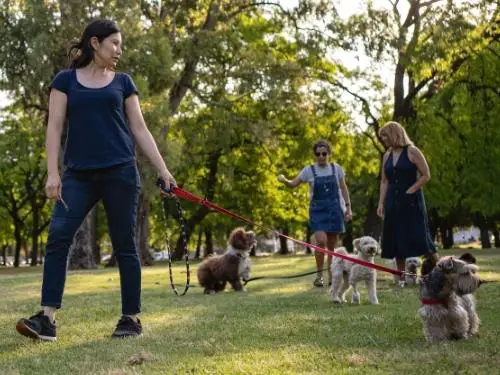Pawscessories is reader-supported. When you buy via links on our site, we may earn an affiliate commission at no cost to you.
Learn more.
Wouldn’t it be nice if dogs came into the world and just knew how to obey our commands? Unfortunately this isn’t the case, and many dogs can be quite frustrating when it comes to training.
It can often feel like all the training you do doesn’t seem to matter at all. Especially when moments come up where you really need them to listen and they just don’t.
For me it’s often been that when inside, my dogs are completely obedient. But, once outside.. all training goes out the window.
They used to never come when called, would be distracted, lack focus, pull on the leash, and just completely ignore anything I said.
Luckily, I found some clever solutions to create a well behaved, obedient dog that everyone dreams of having.
In this article you’ll discover:
- 9 reasons your dog is disobedient & how to fix it
- The dangers associated with a disobedient dog & how to make your dog obey you
- Tips to ensure your dog stays obedient in all situations (even in chaotic environments)
Let’s dive in.
Table of Contents

Dog Obedience Training At Home: 9 Tips To Make Your Dog Obey You
Overview Of How To Teach Obedience To A Dog
Remember, dogs have been bred as companions and working dogs. As a result, never forget the importance of providing your dog with a purpose and ensuring that both their physical and mental requirements are met.
If you can do that then obedience trianing will be easy.
Here are the 9 tips on obedience training for dogs:
- Make Their Reward Irresistible
- Keep Commands Consistent
- Train Them Consistently
- Keep Distractions Minimum
- Consult Your Vet
- Avoid Overwhelming Information
- Stay Calm
- Mental & Physical Stimulation
- Get The Right Equipment
1. Make Their Reward Irresistible
So how do you make your dog obey you?
In order to get a dog to be obedient you need to make it worht while for them. This cna be done by increasing the rate at which you reward them aor you can increase the value of the reward.
It’s much more appealing to a dog to listen if they get rewarded often and with their favorite food.
Would you take the job offering $10,000 a month or the one that paid $20,000 every week? I think you get the point.
The key with your dog is to find that high value thing and give them it every time they listen.
Remember, early stages of training need continuous reinforcement after every successful behavior.
Only once your dog starts to show signs of obedience can you move to reduce the reinforcement rate and value of the treats.
Also, when you change their environment this changes things!
This is because there might be things they value more than the treats you’re offering.
It’s also the same reason some dogs are obedient inside your home but not outside.
Outside there are distractions, smells, sounds and exciting things going on. For them to ‘work’ for you in this environment takes more effort and a better reward.
You need to become the most exciting thing in every environment if you want your dog to listen to your every command.
2. Keep Commands Consistent
Keep everything consistent. This means everyone in your family has to be on the same page.
Also, Keep verbal and non verbal cues the same. If you point down every time you say “come”, continue to do this every time you say it.
Remember, dogs are masters of body language so keeping your verbal and non verbal communications the same will help.
Try your best to only say the command one time, otherwise your dog may learn not to listen the first time you say it.
3. Train Them Consistently
When you start obedience training it needs to be done consistently.
You need to show your pup that when they’re obedient and listen to you great things happen.
Start by teaching them the basic commands: sit, stay, come and down. You can then move on to more advanced commands such as: Heel, Leave it, Drop it and Place.
When starting out, only teach your dog one command at a time. Once they have mastered that you can add in another one.
If you’re someone who has trouble coming up with and sticking to a training routine check out our post reviewing 9 online dog training programs. You might want to consider getting one of these programs.
4. Keep Distractions Minimum
Get your dog into a quiet room with nothing else around. Once they’re successful listening to you in a quiet room, build from there.
You’ll want to gradually increase the amount of distractions present overtime.
Then, once they’re completely obedient without distractions you can move outside into the yard.
Then to your local park or outside in front of your house. And eventually you’ll be able to even take them to the dog park while still having them obedient.
5. Consult Your Vet
Now you might be wondering how consulting a vet can help with getting your dog to obey you. Well it’s more about removing the possibility that your dog is sick or in pain. Dogs in discomfort may not be able to focus on you and their obedience training.
If you have a hunch that your dog may be in discomfort or pain talk with a vet to rule out any health related problems.
Nothing brings peace of mind quite like speaking with a vet. We recently added a service to our website that gives you access to chat with a vet online.
Aside from medical issues, if your dog is anxious or stressed you might want to wait until they are in a better state before training. Also, some situations may make it harder for your dog to listen.
For example, if you’re trying to get your dog to listen to you on a hot summer day, this might make it hard too for them to focus.
So try and make sure there is nothing bothering your dog that could be affecting their obedience.
6. Avoid Overwhelming Information
Avoid ramping up the difficulty and length of your obedience training too quickly.
Instead, the best thing to do is break down the objective/command into several mini steps to help your dog succeed.
Avoid making obedience training sessions too long and stick to short sessions. You’ll get a feel for the ideal length of time for your dog through repetition.
A good tell is your dog will start to lose focus and you’ll notice the tasks becoming harder for them. They may even appear anxious.
Try to end sessions before this happens.
7. Stay Calm
If you notice you’re becoming frustrated, do your best to end your training session.
The key is to make sure you end the session on a positive note. Get your dog to do a simple command, reward them, then end the session.
When you go to train them next time try breaking the training into smaller chunks of time. This can help improve the training experience for you and your pup.
Remember, dogs can feed off of our energy. When you are frustrated and angry, they’ll likely become frustrated too.
8. Mental & Physcial Stimulation
Make sure you’re actively stimulating your pup’s mind throughout the day.
The easiest ways you can stimulate your dog’s mind is through training, walks/exercise, and puzzle toys.
You can check out our list of mind stimulating toys that are great for those days you’re running low on time.
9. Get The Right Equipment
Getting the right dog training equipment to help with obedience training is essential.
This includes dog treats, a dog collar/harness, leash, a clicker (optional), crate etc.
8 Reasons Why Your Dog Might Be Disobedient
1) Are You Rewarding Your Dog Properly?
Although most people will answer “I think so”, the truth is a majority of dog owners (including myself at one point) don’t. The problem here lies in the frequency of rewarding and the value of the reward (to your dog).
Ask yourself this question about the reward you’re giving your dog.
If you were your dog, do you think the reward is sufficient for the work you’re asking them to do?
You know your dog best and you can usually tell if the reward is sufficient because of their level of excitement.
For the same reasons you wouldn’t work for $0.1 an hour is the same reason some dogs are disobedient.
They feel that not listening, barking, pulling on the leash, etc. provides a better reward.
2) Are Your Commands Confusing Your Dog?
Sometimes dogs are raised around a number of different people. Many of which use different commands for training.
Consistency is vital when training obedience. If your commands and body language aren’t consistent your dogs will become confused and frustrated.
3) Has Your Dog Been Properly Trained?
Although no one likes to admit the fault might be their own, dogs that are disobedient usually have poor training.
If their training is inconsistent, there’s no follow through on commands, you’re not firm with poor behavior, or they get improper reinforcement, this all leads to a pup that lacks obedience.
Dogs are incredibly cute and people often let them get away with too much.
If your pup has never been properly trained and has primarily done whatever they want whenever they want, all stages of learning are much more difficult.
4) Is Too Much Going On?

The best way to train any dog is in a quiet room with no other distractions!
This makes you the most exciting thing since nothing else is around to distract them.
Dogs are much more likely to be obedient when they can focus on you. Especially, when starting out since they haven’t been trained to deal with distractions while maintaining focus.
5) Is Your Dog Emotional? Any Health Issues?
Emotions and health related issues can interfere with your dog’s obedience.
Things like fear, overwhelm/overstimulation, pain, anxiety, stress, etc.
Dogs stuck in a negative emotional state will have issues listening which can impair their ability to learn.
Do you remember the last time you tried learning something when you were in pain or overwhelmed?
It makes things much harder!
6) Are You Asking Your Dog Too Much?
Most dogs start out with short attention spans that can be extended with training.
However, it takes time. Some owners try to speed up this process by trying multiple commands in a training session and training their dog for too long.
This can be overwhelming for your dog. Training sessions should be short with easily achievable commands.
Overtime you can slowly move to more advanced things and extend the duration of your sessions.
You may want to consider enrolling in SpiritDog Training’s Perfect Obedience Bundle — After looking at dozens of different programs to help with obedience this is by far the best.
She has over 32,226 students across her trainings with 100% satisfaction.
You get lifetime access to professional dog trainers, on demand step by step video trainings, instructional PDFs, progress tracking, all from the comfort of your home.
So go ahead, try out SpiritDog’s Perfect Obedience Bundle at no risk with their 60-day money back guarantee.
7) Are You Getting Frustrated?
When you get frustrated or annoyed, your dog can tell. Dogs are masters of analyzing body language.
When they know you’re frustrated, mad, or upset, some dogs will completely shut down and become much less obedient.
Try to avoid raising your voice, bending down, or getting in their face, this makes your dog feel intimidated which doesn’t help with obedience.
8) Are You Stimulating Your Dog Enough?

An “idle mind is the devil’s workshop”.
The secret to a well behaved, obedient dog is to make sure they are mentally stimulated and satisfied.
Most dogs actively WANT to work, and when they don’t, they can become destructive, disobedient, and develop poor mental health.
Final Thoughts
When it comes to obedience training for dogs, there are a few key things to remember.
You’ll want to make sure you dog is free of any medical conditions that could be affecting their ability to focus and listen. You should also avoid overwhelming your dog with too much information or training at once.
It’s important to keep obedience training sessions short, positive, and stimulating for your dog. With the right equipment and by following these simple tips, you’ll have your dog obeying you in no time!
